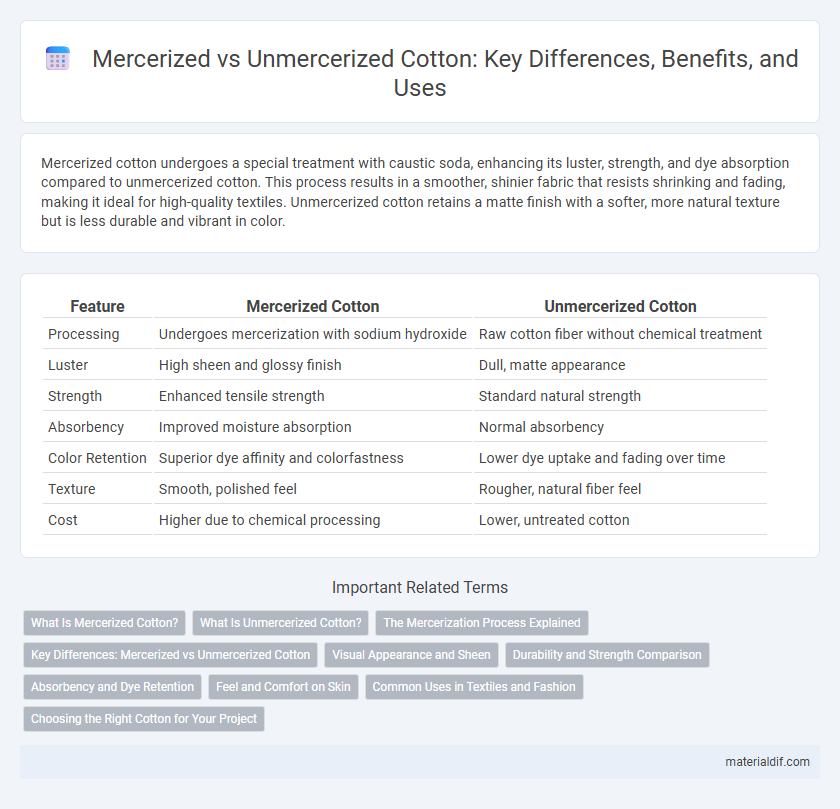Mercerized cotton undergoes a special treatment with caustic soda, enhancing its luster, strength, and dye absorption compared to unmercerized cotton. This process results in a smoother, shinier fabric that resists shrinking and fading, making it ideal for high-quality textiles. Unmercerized cotton retains a matte finish with a softer, more natural texture but is less durable and vibrant in color.
Table of Comparison
| Feature | Mercerized Cotton | Unmercerized Cotton |
|---|---|---|
| Processing | Undergoes mercerization with sodium hydroxide | Raw cotton fiber without chemical treatment |
| Luster | High sheen and glossy finish | Dull, matte appearance |
| Strength | Enhanced tensile strength | Standard natural strength |
| Absorbency | Improved moisture absorption | Normal absorbency |
| Color Retention | Superior dye affinity and colorfastness | Lower dye uptake and fading over time |
| Texture | Smooth, polished feel | Rougher, natural fiber feel |
| Cost | Higher due to chemical processing | Lower, untreated cotton |
What Is Mercerized Cotton?
Mercerized cotton is a specially treated cotton fiber subjected to a sodium hydroxide solution that enhances its strength, luster, and dye affinity. This treatment causes the fibers to swell, resulting in a smoother, shinier surface compared to unmercerized cotton, which retains a more natural, matte finish with less tensile strength. The improved absorption properties of mercerized cotton make it ideal for high-quality textiles and vibrant, long-lasting colors.
What Is Unmercerized Cotton?
Unmercerized cotton refers to cotton fibers that have not undergone the mercerization process, which involves treating the fabric with a caustic soda solution to enhance luster, strength, and dye affinity. This type of cotton retains its natural, matte appearance and has a softer feel but lower tensile strength compared to mercerized cotton. Unmercerized cotton is often preferred for its natural texture and breathability, making it ideal for casual wear and eco-friendly textiles.
The Mercerization Process Explained
The mercerization process involves treating cotton fibers with a strong sodium hydroxide solution, which causes the fibers to swell, straighten, and increase in strength and luster. This chemical treatment enhances the cotton's dye affinity, resulting in richer, more vibrant colors compared to unmercerized cotton. Mercerized cotton also exhibits improved dimensional stability and a smoother texture, making it highly desirable for premium textile products.
Key Differences: Mercerized vs Unmercerized Cotton
Mercerized cotton undergoes a chemical treatment with sodium hydroxide, resulting in increased fiber strength, lustrous appearance, and enhanced dye absorption compared to unmercerized cotton. Unmercerized cotton retains its natural matte finish and softer texture but lacks the durability and vibrant coloration found in mercerized cotton. These differences make mercerized cotton preferred for high-quality textiles, while unmercerized cotton is commonly used for everyday fabrics.
Visual Appearance and Sheen
Mercerized cotton undergoes a chemical treatment that enhances its luster, giving it a smooth, glossy finish and richer color vibrancy compared to unmercerized cotton. Unmercerized cotton retains a matte, duller appearance with less reflective sheen due to the absence of this treatment. The enhanced visual appeal and sheen of mercerized cotton make it a preferred choice for high-quality textiles and premium apparel.
Durability and Strength Comparison
Mercerized cotton undergoes a chemical treatment that strengthens and smooths the fibers, resulting in enhanced durability and resistance to wear compared to unmercerized cotton. The mercerization process increases fiber tensile strength by approximately 20%, making fabrics more robust and less prone to fraying or tearing. Unmercerized cotton, while softer, tends to have lower tensile strength and durability, leading to quicker fabric degradation under frequent use and washing.
Absorbency and Dye Retention
Mercerized cotton undergoes a chemical treatment that enhances fiber strength, resulting in improved absorbency compared to unmercerized cotton. This process also increases dye retention, producing richer, more vibrant colors that resist fading over time. Unmercerized cotton, while softer, absorbs moisture less efficiently and typically exhibits duller colors due to lower dye affinity.
Feel and Comfort on Skin
Mercerized cotton offers a smoother, silkier feel on the skin due to its enhanced luster and tighter fiber structure, providing superior comfort and reduced irritation. Unmercerized cotton has a softer, more natural texture but can feel rougher and less breathable, which may affect comfort during prolonged wear. The enhanced durability and moisture-wicking properties of mercerized cotton contribute significantly to a cooler, more comfortable skin experience.
Common Uses in Textiles and Fashion
Mercerized cotton is favored in textiles and fashion for its enhanced luster, strength, and dye absorption, making it ideal for high-quality garments, luxury bedding, and premium shirts. Unmercerized cotton, known for its natural softness and breathability, is commonly used in everyday clothing, casual wear, and home textiles like towels and quilting fabrics. The choice between mercerized and unmercerized cotton depends on the desired finish, durability, and price point in various textile applications.
Choosing the Right Cotton for Your Project
Mercerized cotton offers enhanced strength, a smoother texture, and vibrant color retention, making it ideal for high-quality garments and detailed embroidery. Unmercerized cotton provides a softer, more natural feel with greater absorbency, suitable for casual clothing and absorbent textiles like towels. Selecting the right cotton depends on the project's durability requirements, texture preference, and colorfastness needs.
Mercerized Cotton vs Unmercerized Cotton Infographic

 materialdif.com
materialdif.com